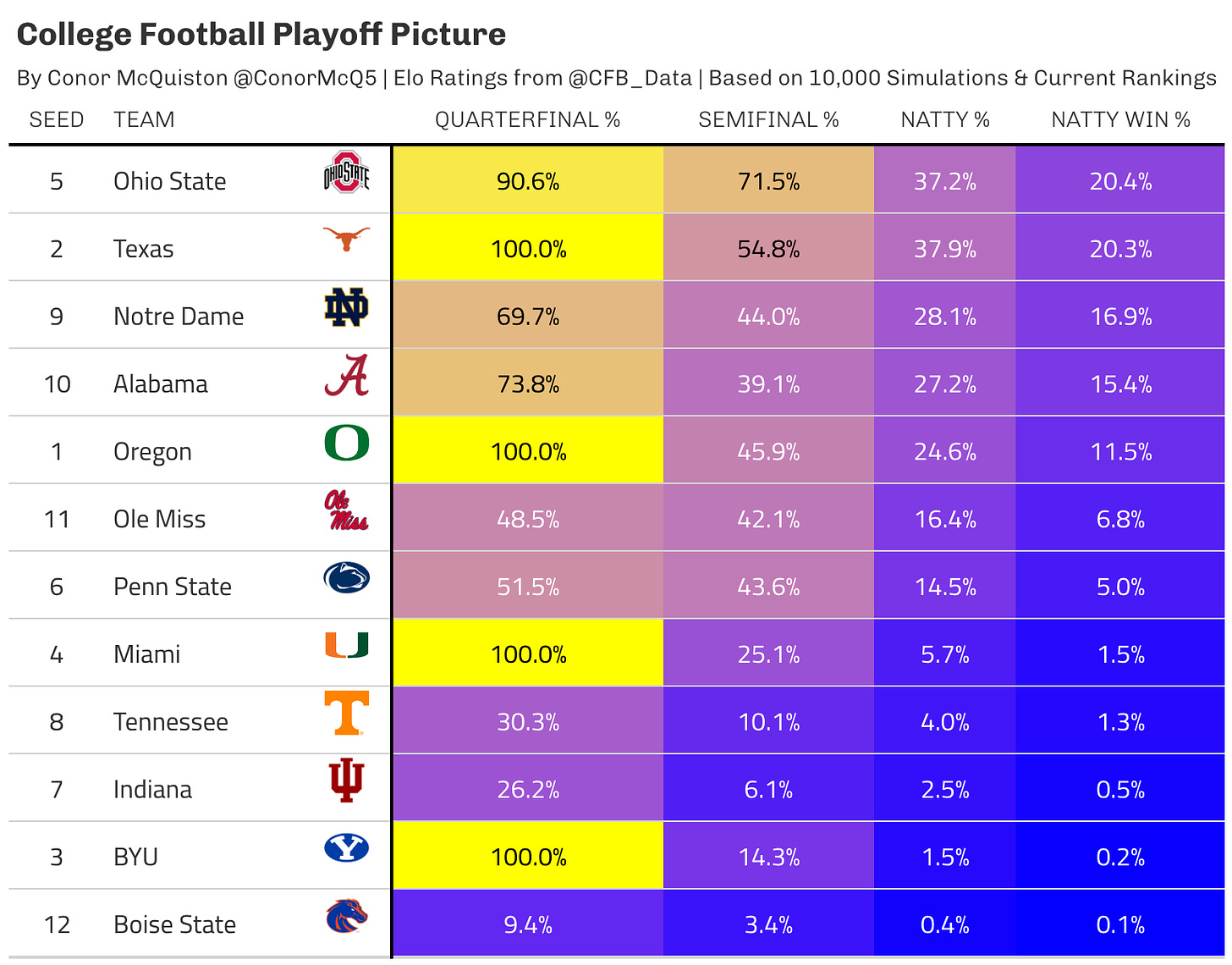The 5 Seed in the College Football Playoff is OP
Ohio State is on track to have the easiest path to win it all
The 5 seed in the college football this year, and in most seasons, will most likely be the 2nd-place team in Big Ten or SEC. In 2024 that is most likely Ohio State or Oregon, with Ohio State currently slated in that place. That team will play - most likely - the highest rated G5 conference champion (Boise State) in the first round, and then the lowest rated P4 conference champion (ACC or Big 12 winner) in the quarterfinal. Given how much better the 2nd-best Big Ten or SEC team is than either of those teams, this confers a huge structural advantage.
If the season were to end today, Ohio State would only have to defeat Boise State and Miami to reach the semifinal where they’d play the ultimate victor of the Tennessee-Notre Dame-Oregon gauntlet. According to my simulations, this would end up with the Buckeyes in the semifinal game a whopping 71.5% of the time. Only Texas has a more than 50% chance to make it that far, and they have a bye and a roughly 25% chance to play Indiana. No other team is in the same universe. From that point the odds even out and they are roughly as likely to win it all as any other of the top 5 teams in the country.
The exact probabilities in this simulations have fairly wide error bars. The method to generate the win probability in a given hypothetical matchup (elo) does not consider anything outside of who they’ve played and if they’ve won. This leaves out a ton of important factors - QB caliber, OL play, any injuries, etc. - so we shouldn’t view 11.5% as hugely different from 20.4%.
That is to say, Ohio State is not a markedly better team than any of the heavy hitters this year. Their loss to Oregon proves that. But because they have a disproportionately easy path to have a chance to finally make it to the promised land, that gives them a leg up over their competition to finally taking home the national championship. And they only get that leg up in the event that they do not win their conference, which seems incredibly unfair.
The important thing to takeaway here is that the #5 seed in the CFP, with its automatic conference qualifiers and unevenly talented conferences, has a structural advantage within the tournament structure. Time will tell to see if it ends up as a long term problem but it may need future reform. The real galaxy brain take here is that Oregon could actually be in a better position in the CFP if they end up losing the Big Ten championship. If you wanted a very clever and contrarian social media take, one could argue that Oregon should try to lose the Big Ten championship since the path to make it from 5 (or maybe even 6) is probably easier than the path from 1. That would never ever happen, but it would get you clicks!
If you enjoyed this post, please subscribe so that you can receive emails updating you upon every post and share this with others who you think might enjoy. This is a free newsletter, but if you are feeling so generous you can buy me a coffee.





That's why a bracket is kind of silly.
I like what baseball used to do, skewing the playoff matchups to avoid rematches. i.e. in round two, Oregon would get the worst team remaining that isn't in the Big Ten. In this case, based on your presented percentages, that's Alabama. Texas would get the worst team remaining that isn't SEC (Notre Dame). BYU would get the worst team that isn't Big 12 (Penn St). SMU would take whoever is left (Ohio State).
That wouldn't entirely fix the problem, but I think it would help weed it out a little bit by making the one seed's path slightly easier, plus do some work to avoid rematches, which I don't think anybody wants to see playoff rematches. An alternate fix to this could be to give all five conference champions top five seeds, eliminating some of the ease of the first round matchup for what would now be sixth seeded Ohio State. At least that way whoever the G5 team is would get to play their game at home, potentially giving them a slightly higher chance to win.